Hello Dear Steemians, Admin @belenguerra, MOD @bright-obias & @worldgeography believe you will love this. The publication focuses on the main museums of traditional art. Culture can be seen as the distinctive, spiritual, material and emotional traits that characterize a society or a social group. It encompasses, in addition to artistic productions, ways of life, fundamental human rights, value systems, beliefs and traditions.
Traditional art museums strengthen the cultural identity of a people; this identity is defined through the multiple historical aspects in which culture is modeled, such as language, an instrument of communication between members of a community, specific social practices, rites and ceremonies, or collective behaviors, value systems and beliefs; its anonymous intangible nature, and its production by the collectivity, is a feature specific to these elements of cultural identity. Identity is linked to history and cultural heritage; traditional art museums are physical spaces in which cultural heritage is valued. These museums highlight the memory and recognition of a people’s past through symbolic or relative elements that are specific to them and that help build the future. They are cultural places where art objects or even exceptional and unique pieces of their kind are exhibited, which tell the story of a people or even a nation.
In Cameroon, there are several museums, whether public or private. Each museum offers a “collective memory route” which guides visitors through the territory to discover places of history, legend and myth, in a dimension of encounter and exchange that enriches the experience of visit.

1- BABUNGO MUSEUM (NORD-WEST CAMEROON)
The Babungo have live in the Upper Nun Valley for centuries, but their museum and palace have only been open to visitors since 2006. The museum and palace are impressive both because of quality and quantity. It is amazing that the Fon was about to keep so much of the chieftaincy’s art and ritual objects in their own collection while so much of the physical culture of Africa had been spirited off to high end commercial art galleries around the globe. Several pieces of the most significant, highest quality pieced were are displayed in the museum (carved and beaded thrones, stools, staffs, musical instruments, jewelry, masks, containers, pipes, etc.).
The quantity element can be viewed at the palace. In the court of the palace there are thousands of sculptures lining the walls literally stacked to the rafters, and hanging from them as well. Also impressive is the coverage of the art; every wall is decorated, every pillar and door frame carved. A lot of the work displayed royal symbols like the double gong, leopard, tortoise, lizard and two-headed snake. Carved figures at fon’s or chief’s or king’s palace at Babungo in Ring Road area Grassfields region Northwest Province Cameroon West Africa Carved by fon himself as part of his traditional role of woodcarver and sculptor.


2- ROYAL BAHAM MUSEUM (WEST CAMEROON)
This beautiful museum was inaugurated in 2003; it is animated around the themes of history-tradition, customs-costumes and objects of communication. Both costumes and communication items constitute living heritages that leave the museum during traditional ceremonies. The Baham Museum is filled with an array of diverse works of art that encapsulate the rich cultural and artistic heritage of the Baham Kingdom. It is a bond of memory between the past and the present so that the younger generations do not forget their origins. We find objects with varied and unique shapes that have a story or an anecdote to tell about the glorious past of this people.
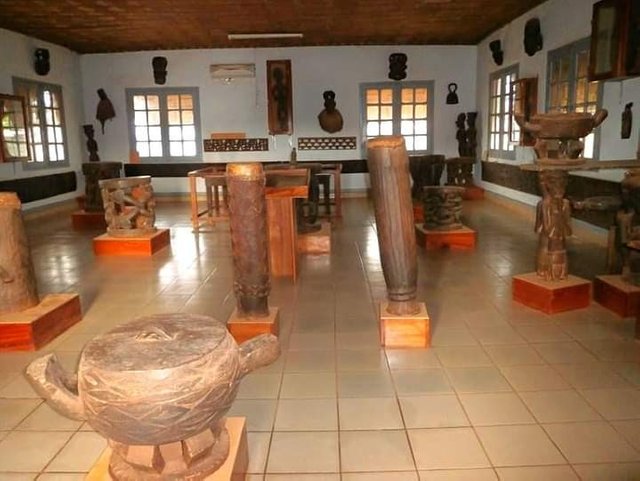


3- NKOLANDOM MUSEUM (SOUTH CAMEROON)
The Museum of Negro Arts at the Nkolandom Tourist Center is a place of preservation, conservation and modernization of Negro African heritage. All the antiquities of the African continent in general and Cameroon in particular are there: The various objects carved in wood, copper, bronze represent fishing, habitat, hunting, wealth of clothing, cooking, music , sculpture, forge, painting, cosmogony, chiefdoms etc ...


4- THE ETHNOGRAPHIC MUSEUM OF THE PEOPLES OF THE FOREST (CENTER CAMEROON)
This museum offers quite a fascinating and enriching discovery of the history and customs of the peoples who lived in this place. It was created to preserve the ancestral vestiges which are still found in this atypical environment.


5- CULTURAL CENTER AND MUSEUM IN THE LOGONE VALLEY (FAR NORTH CAMEROON)
The Cultural Center and Museum in the Logone Valley is intended to be a place of dialogue and intercommunity meeting, a place in which, going beyond ethnic particularities, people of different languages and cultures can live together and in harmony who today are part of of a single community. It is called upon to become a reference center specializing in research, an archive and consultation center for all the information available on the culture of the different populations of the Logone Valley.



6- NGAN-HA MUSEUM (ADAMAOUA CAMEROON)
The historical value of the collection as a material for the history of the Mboum people, its unique and exceptional character encouraged the preservation and conservation of these particular works. The Ngan-Ha Museum was opened to the public in 2001. For six months, Merete Winness, a Norwegian curator attached to Nina-Niku, settled in Ngan-Ha for the inventory, processing and recording of the pieces. Two hundred objects will be identified, measured, photographed and briefly described. They were then arranged on the shelves of wooden shelves by category: ornaments, hairstyles, containers, parade weapons, throwing knives, pipes, sound shapes, thrones, adzes, etc. From now on, anyone who goes to Ngan-Ha, could appreciate these objects exhibited in a small box which serves as a museum and he can also record his impressions in a guest book provided for this purpose.


7- MUSEUM OF CIVILIZATIONS OF DSCHANG (WEST CAMEROON)
It was created by the authorities in 2011 in the city of Dschang. More than a museum, it is a scientific place that offers a certain perspective on the evolution, the history of traditional peoples across Cameroon. It is a crossroads of the cultural heritage of all areas of Africa in miniature, Cameroon. The Museum of Civilizations invites you to discover the origins of the Cameroonian people and the diversity of the 4 major cultural areas of the country through their history but also their artistic productions, their architecture and their socio-political organization. The common thread of the exhibition is based on the civilizations of Cameroon and their developments over time. This theme is presented in the exhibition:
- from a historical perspective: the origins of the civilizations of Cameroon, the migrations of peoples, their settlement on the territory, their current entanglement ...
- from an ethnological and sociological perspective: through their architectural and artistic creations, their rites and beliefs ...
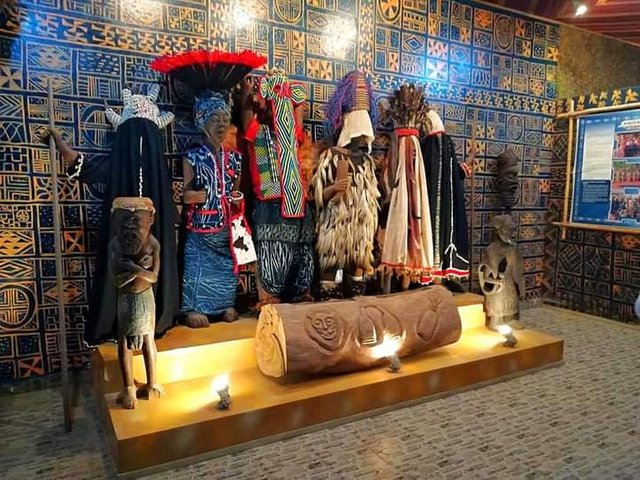

8- MANKON MUSEUM (NORTH WEST CAMEROON)
The Mankon Museum is an art and cultural museum located in Mankon-Bamenda, Cameroon. The museum was inaugurated in 2006, and is situated at the entrance to the Mankon Palace. Many of the historical objects in the collection came directly from the palace. These include some items that traditionally were not supposed to be seen by the general public, a situation that upset some members of the local community.


9- NEW MUSEUM OF THE BAMOUN KINGS (WEST CAMEROON)
It is one of the oldest in the country, which brings together 12,000 pieces (ancient utensils, royal tunics and above all sculptures). It is one of the most beautiful architectural gems in Cameroon. It is the work of the Sultan King of Bamoun, Ibrahim Mbombo Njoya. This new edifice in the shape of a two-headed serpent that represents the power of the Bamoum people, overlooked by a spider that symbolizes wisdom, is the largest museum in Cameroon. Everything has been thought of to make this place a major tourist attraction. There is an important collection of Bamoun works of art, some inventions of King Njoya the builder, as well as several other symbolic objects of royal power.


10- MUSEUM OF THE HORSE OF THE LAMAIDAT DEMSA (FAR NORTH CAMEROON)
The lamidate of Demsa is particularly known for its fantasias which are famous for the number of participating horses. The horse is also central in this lamidate since the Lamido has opened a horse museum on its property and maintains a hundred horses.

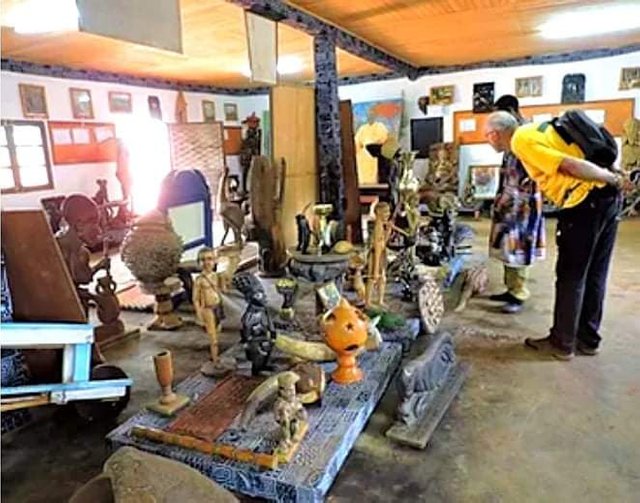
11- NATIONAL MUSEUM OF YAOUNDE (CENTER CAMEROON)
Occupying the former palace of the governor of Yaoundé, itself transformed into a presidential palace, the National Museum has benefited from a complete renovation since 2009. When it reopened in January 2015, this complex with an area of 5,000 m2 was finally found a new lease of life. And what a breath! The acquisition for around 4 billion CFA francs of several hundred rare pieces and traditional objects allows visitors to offer a very wide range of Cameroonian culture and in the most beautiful way exalts the unity and grandeur of the country. .
Even before entering this splendid museum, you will be impressed by the series of bronze statues that stand on the forecourt - warriors, musicians and hunters - and pay homage to the Bamoun people. Once inside, you will enjoy strolling through the huge rooms which display relics of daily life from the past (musical instruments, kitchen utensils), attributes of traditional nobility - in particular the famous Ngiii, tribal mask in wood - but also portraits of personalities who have marked political and cultural history since the independence of Cameroon.


12- BATOUFAM MUSEUM (WEST CAMEROON)
The Batoufam Open Air Museum remains one of the richest and most original in Cameroon. It is made up of a set of circuits, works of art, spaces, buildings, etc., the central theme of which is "Architecture, Power and Social Cohesion". This theme is an enhancement of the primordial role that Architecture played in the founding process of this village. Indeed, spatially, this Chiefdom is a “Labyrinth”. During the tour of the museum, the visitor is invited to stroll through this maze of courtyards and corridors, to discover the history and the Batoufam society: architecture being a common thread of the exhibition. Perceived in this context, Architecture is used as a politico-social tool, and is then defined as "the material expression of a system of thought and organization of power, an art which takes into account all the parameters of security, protection, conservation of virtues and safeguard of values.


13- BAPA MUSEUM (WEST CAMEROON)
The Bapa Museum was inaugurated on February 24, 2018. It was on the occasion of the first edition of Pa’a Ngouok. A festival bringing together all the sons and daughters of this locality located in the commune of Bangou. This museum is housed in the center of the upper chiefdom of Bapa. It is built to mirror the architectural surroundings of the village. More than a museum, it is a place of contemplation and communion with spirits. And inside it, there are several objects that have been used in the past. On the walls, you can see paintings evoking the history of successions within the chiefdom, traditional royal attire and many other remains that have been carefully preserved.


14- COMMUNITY MUSEUM OF BAMENDJOU (WEST CAMEROON)
Dedicated to Cameroonian art, the museum's first space traces the history of the chiefdom from its first migrations to its establishment and current developments. The second space, dedicated to creators, highlights the artistic richness of the Bamendjou people, in particular old and contemporary plastic creation.
The Royal Museum of Bamendjou is the main place or space for the exhibition of the artistic knowledge and know-how of the Bamendjou people. Located within the walls of the palace, the grand royal museum contains lush statues retracing the long and rich history of the Bamendjou.


15- COMMUNITY MUSEUM OF BANDJOUN (WEST CAMEROON)
The museum presents more than a hundred major and significant objects of the cultural and artistic heritage of Bandjoun, one of the main centers of creation and artistic tradition of the Cameroonian Grassland. There are rare pieces there, including some masterpieces of African art. They celebrate the splendor of the court of the kings of Bandjoun, the greatness and the power of these monarchs and their collaborators, the solidity of the institutions. They too materialize universal themes like death, life, defeat, love, victory, power, prestige, occult strength, etc. The superb royal thrones, the magnificent masks and beaded objects, the architectural elements with rich decoration, the fabrics with enigmatic patterns, various cultural objects sometimes expression of the life cycle, are often of great quality of execution, of an indisputable authenticity, cultural witnesses of great aesthetic and / or historical, social value.
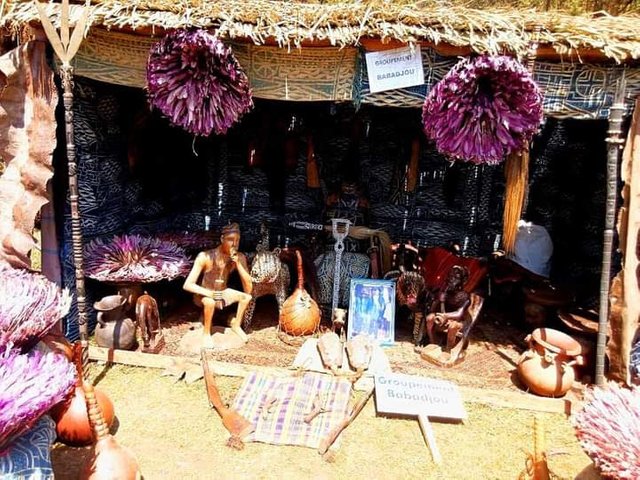

16- MUSEUM OF THE CHEFFERIE BAFOUSSAM (WEST CAMEROON)
It contains a rich collection of works of art that traces social life, the first rudimentary tools therefore used by the people, but also royal symbols which reflect the power of the chief over all populations. Works that are unique pieces that have belonged to several lines of chefs. It is also a demonstration of the artistic knowledge of the Bafoussam people who have preserved this heritage for centuries.

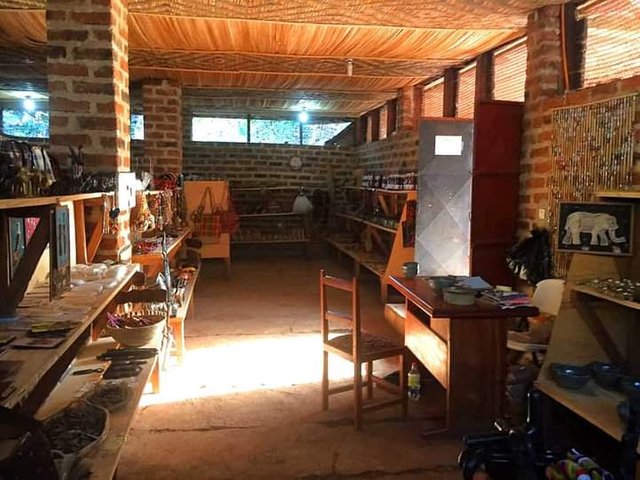
17- BAFUT MUSEUM (NORTH WEST CAMEROON)
Bafut is blessed with rich cultural touristic attractions such as museums, arts and crafts, festivals, the Bafut / Bawum palace, historical attractions and buildings, and cultural displays which are spatially distributed. The Bafut palace museum is compartmentalized and includes peculiar sections such as the queen's mother room, the German Bafut war room, slave trade room, royal animals, ancient musicians and traditional dance instruments. The palace museum presently hosts a wealth of varied antiquities and artistic patrimonies. The museum which is a major source of touristic attraction is also in a plural perspective, with a combination of the historical, ethnographic, stylistic, and anthropological, aesthetics analysis and a collection of objects linked to the rites of the prestige nature of the Bafut inhabitants .
The Bafut royal arts and craft is the most significant in the area. Its age and history attached is a driving force to visitors. Within the palace is a purely traditional house called “achum” constructed with local materials. It is roofed with grass and the walls with bamboos decorated with carved and designed wood. The fon’s wives “bangyue buntoh”, princes and princesses “mboh ntoh” engage themselves in the production of craft made out of local material like bamboos, Indian bamboo, raffia palm, calabashes, wood and the production of the North west traditional regalia. In Bafut palace, more than one hundred people are involved in craft work either as suppliers of raw materials or in the production of the craft itself. The articles are mostly exhibited during the annual Bafut cultural dance.


18- BANGOUA MUSEUM (WEST CAMEROON)
While walking through this Hut, German visitors were able to observe the photographs, masks, statuettes, plastic paintings and other literary works retracing the epic of this people founded around 1440 by Fô Leukemegne, also called Fô Djouvup. This museum, modernized in 2009 under the theme: "Art, hunting and traditions", highlights the culture of the Bangoua region. We discover the socio-cultural life of this people. A cultural picture completed by the release of the legendary Kougang dance.


19- MUS'ART GALLERY - KUMBO (WEST CAMEROON)
The Musa Heritage Gallery shortened The Mus'Art Gallery is a museum that focuses on the arts and crafts of the Western Grassfields of Cameroon. Also known as the Grass-fields Arts Museum. The Musa Heritage Gallery seeks to preserve and promote the arts and crafts of the Grassfields of Cameroon. This region which includes the North West and West Provinces is widely recognized internationally for having produced masterpieces of Arts and Crafts of Cameroon. The Musa Heritage Gallery (abbreviated Mus'Art Gallery) therefore has the mission of publicizing publicly the Arts and Crafts of this region of Cameroon in Cameroon and internationally. This is done through a better understanding and appreciation of the material culture of the inhabitants of the Cameroonian Grassfields expressed through their varied and diverse art forms. Also active in the fields of arts, culture, development and music information. This museum is mainly managed by the Musa family, owners of the Musa Heritage Gallery.
For the past fourteen years, the shortened Musa Heritage Gallery Mus'Art has been active in the propagation of Nso 'cultural heritage. The museum named in memory of Nso sculptors' Daniel Kanjo Musa and his eldest son John Yuniwo Musa has been at the forefront of promoting traditional Nso arts and crafts. This artistic and cultural institution of the Musa family opened its doors to the public on December 18, 1996. The MusArt Gallery has a collection of over 400 objects, most of which were created between 1970 and 2000. These varied and varied objects range from work from bamboo to woodcarvings, from basketry to pottery.
The museum continues to acquire contemporary Cameroonian arts and crafts while focusing primarily on the Western Grass-fields region. This region is internationally recognized for having produced masterpieces of African art. Unfortunately, these objects were appropriated by missionaries and colonial officers and transported from their place of origin to museums in Europe or the United States of America. The masterpieces of grassland art are today in foreign museums and it is very likely that they will never be returned. The statue of Ngonnso's founder, the Nso kingdom, is currently housed in a museum in Germany. In Nso, there is an outcry for this statue to be returned to his people.

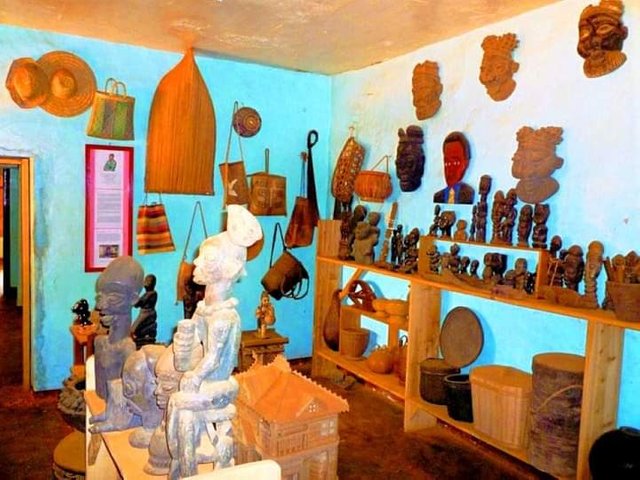
20- SOUL OF OKU MUSEUM (NORTH WEST CAMEROON)
The Soul of Oku Museum (SOOM) is a cultural and touristic center in the Oku Palace. It has a craft shop for local objects of arts and a Cafe.
The Soul of Oku Museum (SOOM) is a non-profit making, permanent institution in the service of the Oku people and of their development, and open to the public. It acquires, conserves, researches, communicates and exhibits, for purposes of study, education and enjoyment, material evidence of the people and their environment. It equally runs a craft shop for marketing of local objects of arts and a Cafe where you can consume Oku brand of Organic Coffee, Oku White Honey and other locally made fufu cakes . The SOOM found in the palace was created for public display of information and antiquities related to the customs and traditions of the Oku people. This equally serves to raise funds for the promotion and conservation of the cultural heritage.


21- MUSEUM OF BLACKITUDE OF YAOUNDE (CENTER CAMEROON)
Since October 23, 2008, the city of Yaoundé has been welcoming a new museum that its founder, also vice-president of ICOM (International Council or Museum) Cameroon, His Majesty Fô Nab Ngo I Nana Sunjio Agnès, called “Musée La Blackitude ". A member of the Bahouoc royal family, she inherited art collections from her father and the kings of other chiefdoms of the Bamileke plateau. In March 1998 she decided to carry out her museum project in order to "conserve, document, enhance and disseminate the arts and cultures of Cameroon and Africa in all their aspects"
The museum houses works of art mostly from the Grassfields but also from the Fang-Beti ethnic groups. Today it presents a beautiful collection of statuettes, wooden and bronze statues, traditional dance costumes, wooden and ceramic rituals, masks, attributes of power, royal furniture etc ... Some of them , like scrapers and arrowheads, are copies of original lithic tools collected in archaeological laboratories in Portugal by curator Apollinaire Kaji in 2012.
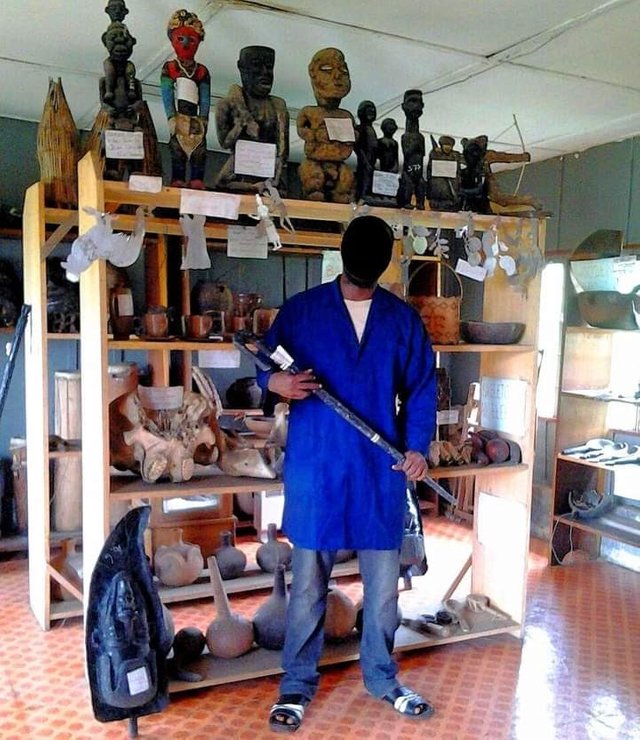

22- MUSEUM OF THE CHEFFERIE BAFOU (WEST CAMEROON)
In the palace, an interesting museum traces the entire history of the chiefdom and has many works of art. A fresco represents His Majesty Kana I who allowed the expansion of the Bafou territory towards the north until then occupied by the Bamock people, towards the west at the expense of Foto by seizing the territories of Lepouo and Tsuèto'o.


23- COMMUNITY MUSEUM OF BAMENDJINDA (WEST CAMEROON)
The Bamendjinda Community Museum brilliantly traces the period of the slave trade by differentiating customary slavery from slave slavery. For the slave trade, the story evokes the small town of Bimbia, near Limbé, from where men and women left for unknown destinies.

24- MUSEUM OF ARTS AND TRADITION SAO KOTOKO DE GOULFEY
The Goulfey Museum is located on the left at the entrance to the cultural complex. It is built in adobe and has an octagonal shape with an area of 14, 65m2. This museum does not impose any traffic restrictions on the public and is full of Sao collections made up of objects in inherited earth, kitchen utensils made of wood, calabash, basketry, hunting and fishing instruments precisely from the miniaturized Zemi. There is also a collection on textiles which takes into account the evolution of clothing in this city.

SOURCES:
- Ateba Ossende Fernand Ghislain. Curator of the Blackitude Museum; Researcher / Teacher of the University of Yaoundé I (Department of Arts and Archeology).
- Jude Ndzifon Kimengsi & Ambe Ernestine Lum (2018). “An analysis of the potential development implications of cultural tourism in North West Cameroon”. Canadian journal of tropical geography / Revue canadienne de géographie naturelle [Online], Vol. (5) 1. Online in May 15, 2018, pp. 01-07.
- Mathias Alubafi Fuba. Human Sciences Research Council (HSRC), South Africa. Modern museums in the palaces of the western Grassfields, Cameroon. Afrika focus - Volume 29, Nr. 2, 2016 - pp. 21-37.
- Nizésété Welcome Denis. Associate Professor - Department of History - University of Ngaoundéré / Cameroon. The Fè Mboum collection from the Ngan-Ha museum in Adamaoua, Cameroon. Material for the history of the Mboum and the issue of its conservation and enhancement. Creative Commons Attribution License, 2016.
- Peter Musa, Director Mus'Art Gallery, http://www.connectcp.org/petermusa
- Wikipedia